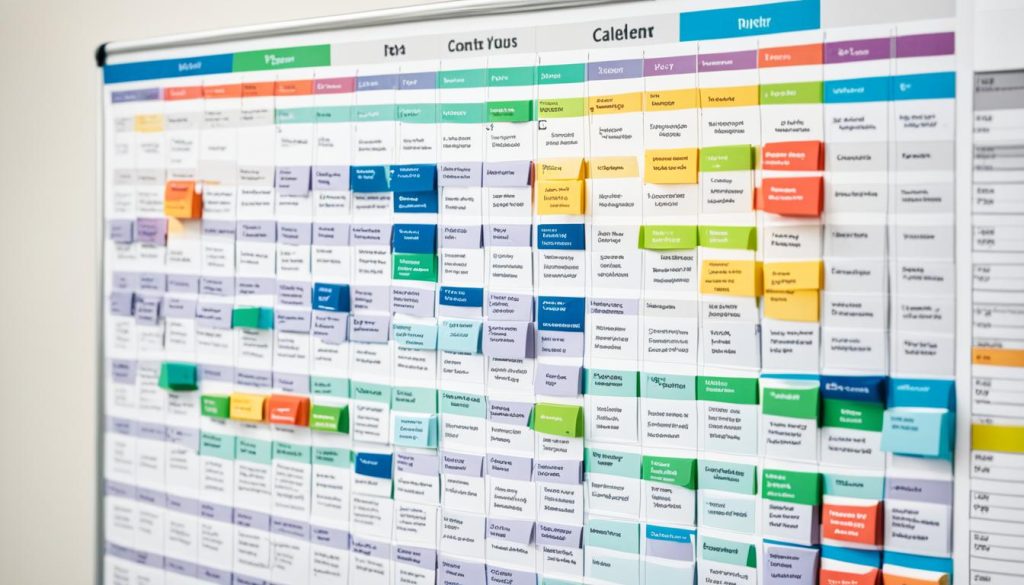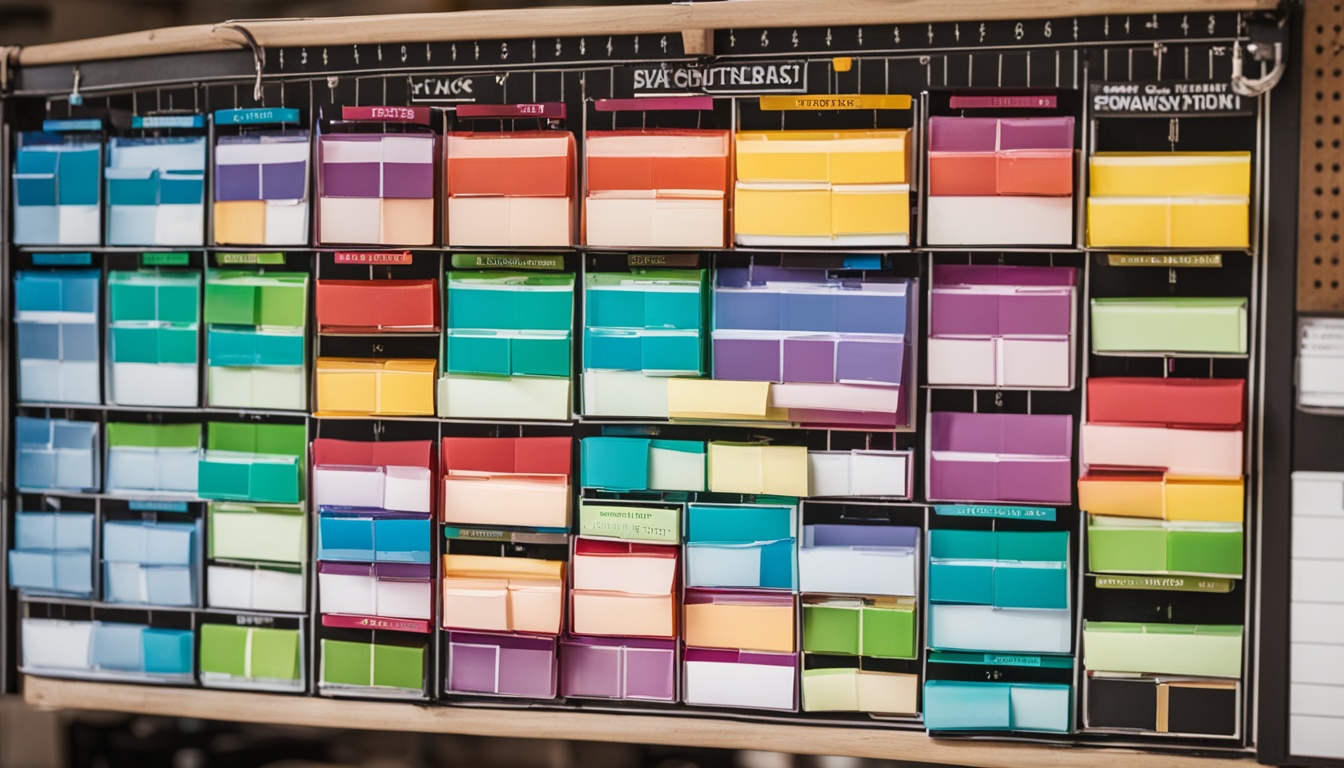Ever wondered why some blogs always have new content? The answer is maintaining consistency in blog posting. A study shows that regular bloggers get 55% more website traffic than those who don’t. Consistency is key for a successful blog.
We’ll dive into how to keep your blog consistent. We’ll cover setting goals, using the right tools, and more. Get ready to make your blog a hit with your audience and see real results.
The Importance of Consistency in Content Creation
Keeping up with blog posting consistency is key. It means having a solid content calendar and sticking to a regular blogging frequency. This approach helps build trust with your audience and boosts search engine optimization (SEO). It also makes your content more relevant to your niche and helps you repurpose content effectively.
Being consistent in your content makes your brand more credible. It also opens up chances for guest blogging and using strong analytics tracking. When you regularly share quality content, your audience learns to rely on you. This keeps them engaged and loyal.
Choosing consistency in your content strategy is a smart move. It helps you grow online, sustainably, and establish your authority in your field. By matching your editorial workflow with what your audience likes, you make a lasting impact. This sets your brand up for success over time.
| Key Benefits of Consistent Content Creation | Metrics to Track |
|---|---|
|
|
Setting Clear Content Goals for Your Blog
Before you start blogging consistently, you need to know what you want to achieve. What kind of posts will you make, and why? Having clear goals helps you know what to share on social media and meet your audience’s needs.
Identifying Your Target Audience
Take the time to identify your target audience. Who do you make content for, and what do they care about? Knowing your audience helps you plan your blog and make sure it hits the mark.
Defining Your Content Pillars
Then, decide on your content pillars – the main topics that define your blog. These should match what your audience needs and help with SEO. Focusing on a few key areas makes your content strategy strong and engaging.
Make sure your content goals are clear, measurable, and fit with your blog’s big picture. By knowing who you’re writing for and what topics to focus on, you’ll be ready for consistent and effective blogging.

| Content Pillar | Example Topics | Audience Relevance | SEO Potential |
|---|---|---|---|
| Productivity Hacks |
|
|
|
| Wellness Routines |
|
|
|
Understanding the Difference Between Consistency and Frequency
When you’re blogging, knowing the difference between consistency and frequency is key. Consistency means sticking to a set posting schedule over time. Frequency is how often you publish new content.
Finding the right blogging frequency is a big step. But, it’s being consistent with your content calendar and editorial workflow that really matters. This consistency boosts audience engagement, search engine optimization, and your niche relevance.
Posting regularly and consistently can help you repurpose content, get guest blogging chances, and improve your strategy with analytics tracking. The goal is to find a frequency that fits you and your readers. Then, stick to it consistently.

| Consistency | Frequency |
|---|---|
| Sticking to a predetermined posting schedule over time | How often you choose to publish new content |
| Drives audience engagement, SEO, and niche relevance | Determines the cadence of your content strategy |
| Requires commitment and discipline | Depends on your resources and audience preferences |
Maintaining blog posting consistency
It’s key to have a regular blog posting schedule to keep your audience engaged and your online presence strong. Don’t just post whenever you feel like it. Instead, set aside a specific day or time each week for creating new blog posts. This consistent approach keeps your content flowing and keeps your audience coming back for more.
Being consistent with your blog posts can also boost your SEO. Search engines like websites that update regularly with fresh, relevant content. This shows they’re active and valuable to users. By posting regularly, you can get your site seen more in search results and draw in more qualified visitors.
| Benefit | Description |
|---|---|
| Audience Engagement | Consistent blog posts help build a loyal, engaged audience who come to expect and look forward to your content. |
| Search Engine Optimization | Regular, high-quality content updates improve your website’s search engine visibility and rankings. |
| Content Repurposing | Consistent blogging allows you to repurpose content across different platforms, such as social media, email newsletters, and guest posts. |

To keep up with blog posting, think about creating an editorial workflow and using a content calendar. This helps you stay organized, keeps new posts coming, and prevents last-minute stress. Also, set clear goals for how often you’ll post and stick to them. Adjust as needed based on how your audience reacts and your own abilities.
Planning and Scheduling Your Content in Advance
Keeping a steady flow of blog posts is key to building a loyal audience. Planning and scheduling your content ahead is a great way to do this. A content calendar helps keep your posts in line with your editorial workflow and what your audience wants.
Creating a Content Calendar
A good content calendar keeps you organized and on schedule with your blogging frequency. Think about these points when making your calendar:
- Know your target audience and what they like to read
- Stick to your content pillars for niche relevance
- Plan for repurposing content and guest blogging chances
- Use search engine optimization (SEO) tips to boost audience engagement
- Look at your analytics to see how well your content is doing and make smart choices
Using a Content Management System
A content management system (CMS) makes planning, scheduling, and publishing easier. With a CMS, you can:
- Work better with your team
- Set up automatic publishing for steady blog posting
- Keep an eye on your audience engagement and tweak your content strategy
- Share your content easily across different places
Planning and scheduling your content early helps you avoid the stress of rushing to create posts. It lets you focus on making high-quality, useful content for your audience. This way, you keep a steady blog posting consistency and engage with your readers deeply.

Batching Your Content Creation Process
Keeping a regular blog schedule is key to keeping your audience interested and boosting your SEO. Batching your content creation is a great way to stay consistent. Set aside a day or a block of time each week to work on several blog posts at once. This saves time and keeps you on track.
Batching lets you focus on your work without daily distractions. This focused work makes you more productive and efficient. You’ll keep producing high-quality content for your readers. Planning and scheduling your posts ahead also helps keep your blog regular. This is important for keeping your audience engaged and making your content more relevant to your niche.
To start batching your content creation, follow these steps:
- Find your most productive hours or days and dedicate them to making content.
- Plan your blog topics early, making sure they match your audience’s interests and your content themes.
- Write and optimize your blog posts, including keywords for search engine optimization.
- Use a content calendar or content management system to schedule your posts.
- Turn your content into social media posts, email newsletters, or guest blog articles.
- Look at your blog’s analytics to see how your content is doing and improve your editorial workflow as needed.
Batching your content helps you keep a steady flow of valuable posts for your audience. This can lead to more audience engagement, better SEO, and more opportunities through guest blogging and repurposing your content.

| Benefits of Batching Content Creation | Challenges to Consider |
|---|---|
|
|
Utilizing Scheduling Tools for Automated Posting
In today’s fast-paced blogging world, keeping up with a regular posting schedule can be tough. But, with scheduling tools, you can make your editorial workflow smoother. These tools help you plan, schedule, and automate your blog posts. This way, you can save time to focus on other business tasks.
Using scheduling tools helps you keep a steady blog posting consistency. You can plan your content ahead and set it to publish at the best times. This helps you avoid missing posts and hitting your blogging frequency targets. It keeps your audience engaged and boosts your search engine optimization (SEO) and niche relevance.
Tools like Later, Planoly, and CoSchedule make managing your content calendar and editorial workflow easier. You can easily add content, set up publishing times, and check how your audience engages with your posts. Automating your posts means your blog stays active and fresh, even when you’re busy.
Whether you’re an experienced blogger or just starting, using scheduling tools can change the game. These tools help you keep a steady posting schedule, repurpose content, and find guest blogging chances. You can focus on giving your audience great content.
| Tool | Key Features | Pricing |
|---|---|---|
| Later |
|
Free plan, paid plans starting at $15/month |
| Planoly |
|
Free plan, paid plans starting at $7/month |
| CoSchedule |
|
Paid plans starting at $29/month |
Listening to Your Audience and Analyzing Engagement
It’s key to connect with your audience and check how your blog is doing. This keeps your content fresh and engaging. By looking at comments and messages, you learn what your readers like.
Monitoring Comments and Direct Messages
Keep an eye on your blog’s comments and messages from readers. This feedback shows what problems they face, what they’re interested in, and what they like. Use this to make your content better and more relevant.
Tracking Analytics and Metrics
Use tools like Google Analytics to see how people interact with your blog. Look at page views, time spent on pages, and bounce rates. This info helps you see what’s working and what’s not. It guides you in making your content more valuable and engaging.
| Metric | Description | Importance |
|---|---|---|
| Page Views | The number of times a page on your website is viewed. | Shows how popular and visible your content is. |
| Time on Page | The average time users spend on a page. | Shows how engaging and relevant your content is. |
| Bounce Rate | The percentage of visitors who leave after seeing just one page. | Helps spot content that doesn’t connect with your audience. |
By watching comments, messages, and analytics, you get insights to improve your blog. This makes your content more engaging and relevant. It boosts your audience’s interest and helps your blog succeed.
Cultivating a Healthy Relationship with Social Media
In today’s world, it’s key to have a good relationship with social media. As a content creator, watch how much social media you use and choose who you follow carefully. Make rules for yourself, like not checking social media in the morning or before sleep. This helps you keep your mind healthy and focus on making great content.
Your audience engagement and niche relevance depend on how well you use social media. Keep an eye on how often you post and how you plan your content. This way, you can avoid getting burned out and keep giving your readers what they want.
Using analytics tracking and search engine optimization helps you see how people interact with your content. This info can guide your content calendar and repurposing content plans. This ensures you always have the right content for your followers.
Having a good relationship with social media means finding a balance between using it and taking care of yourself. Set clear limits, focus on your health, and match your social media plan with your maintaining blog posting consistency. This way, you can keep making content that your audience loves and support your blogging career in the long run.
| Social Media Metric | Benchmark | Your Current Performance |
|---|---|---|
| Follower Growth Rate | 5-10% monthly | 8% |
| Engagement Rate | 1-5% per post | 3.2% |
| Click-Through Rate | 0.5-2% per post | 1.8% |
Showing Up and Engaging with Your Community
Running a successful blog is more than just posting often. It’s key to interact with your community too. Answering comments, messages, and more builds trust and shows you care about your readers.
Being active on your blog and social media helps you grow a loyal group of followers. This leads to deeper conversations and insights that can guide your future posts.
Prioritizing Audience Engagement
Always check and reply to comments on your blog and social media. Talk to your audience by answering their questions and showing real interest in their views.
- Reply to comments quickly to show you value their thoughts.
- Ask more questions to keep the conversation going and learn what your audience likes.
- Say thanks for the good words to keep everyone’s spirits high and strengthen your bond with your followers.
Leveraging Social Media for Community Building
Don’t forget to be active on social media too. It lets you reach more people, share your work, and talk with your audience right away.
- Consistent Posting: Keep posting regularly on social media to stay in your followers’ minds.
- Engaging Content: Mix up your posts with fun, helpful, and thought-provoking stuff to keep people interested.
- Responsive Communication: Answer comments, messages, and mentions quickly to show you’re all in with your community.
By being there and talking with your community, you create a place where people feel they belong. This loyalty is key to your blog’s long-term success.
Developing a Strategy for Storytelling on Social Media
Marketers are now using social media to tell their brand’s story and connect with people. Using platforms like Instagram, TikTok, and YouTube can help build trust with your followers. It’s a great way to strengthen your brand’s relationship with your audience.
First, figure out what kind of compelling, authentic content your audience likes. This could be behind-the-scenes looks, Q&A sessions, or short videos that show what your business is all about. The goal is to keep sharing stories regularly to keep your audience interested and wanting more.
- Create a content calendar to plan and schedule your social media stories.
- Use visual storytelling on platforms like Instagram and TikTok.
- Try short-form video content to grab your audience’s attention.
- Look at audience engagement metrics to make your storytelling better.
- Share and cross-promote your social content on different channels.
Show off your brand’s unique personality and values in a way that speaks to your audience. With consistent, real storytelling, you can build trust, boost audience engagement, and drive more traffic and sales for your blog and business.
Embracing Imperfection and Continuous Improvement
In the world of blogging and content creation, it’s key to post regularly. But, it’s not all about being perfect. The idea of continuous improvement is vital for success online.
Perfection can slow down progress. Instead, focus on making valuable content regularly. Use what your audience says and analytics to improve your plan. Don’t hesitate to change things if they’re not working.
Being consistent is more crucial than being perfect in blogging. By accepting imperfections and always improving, you can grow a loyal audience. This approach also helps you rank better on search engines.
Jump into your niche, reuse your content, and try guest blogging. Keep in touch with your followers, check your analytics, and tweak your plans as needed. Building a successful blog is about accepting flaws and always getting better at making content and engaging with your audience.
| Key Takeaways | Benefits of Embracing Imperfection |
|---|---|
|
|
Leveraging Tools and Resources for Efficient Content Creation
When you aim for blog posting consistency, many tools and resources can help. Platforms like Later, ChatGPT, and Unsplash make scheduling, automating, and finding great visuals easier. These tools save time, make your workflow better, and help you create content that connects with your audience.
Looking into different tools and resources can help you find what works best for you. Whether you want to make blogging easier, improve how you engage with your audience, or boost your search engine rankings, there are solutions out there. Use technology to your advantage and these resources to increase your productivity and keep your content fresh and relevant.
Creating content regularly doesn’t have to be hard. By using guest blogging and checking your analytics, you can make your content strategy even better. Use the tools and resources you have, and see how your content creation gets more efficient and impactful.

